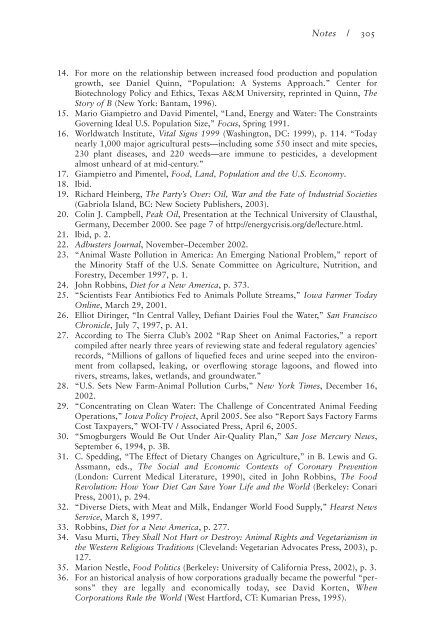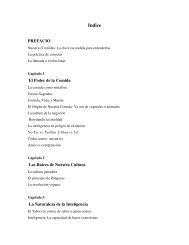The World Peace Diet: Eating For Spiritual Health And Social Harmony
The World Peace Diet: Eating For Spiritual Health And Social Harmony
The World Peace Diet: Eating For Spiritual Health And Social Harmony
You also want an ePaper? Increase the reach of your titles
YUMPU automatically turns print PDFs into web optimized ePapers that Google loves.
Notes / 305<br />
14. <strong>For</strong> more on the relationship between increased food production and population<br />
growth, see Daniel Quinn, “Population: A Systems Approach.” Center for<br />
Biotechnology Policy and Ethics, Texas A&M University, reprinted in Quinn, <strong>The</strong><br />
Story of B (New York: Bantam, 1996).<br />
15. Mario Giampietro and David Pimentel, “Land, Energy and Water: <strong>The</strong> Constraints<br />
Governing Ideal U.S. Population Size,” Focus, Spring 1991.<br />
16. <strong>World</strong>watch Institute, Vital Signs 1999 (Washington, DC: 1999), p. 114. “Today<br />
nearly 1,000 major agricultural pests—including some 550 insect and mite species,<br />
230 plant diseases, and 220 weeds—are immune to pesticides, a development<br />
almost unheard of at mid-century.”<br />
17. Giampietro and Pimentel, Food, Land, Population and the U.S. Economy.<br />
18. Ibid.<br />
19. Richard Heinberg, <strong>The</strong> Party’s Over: Oil, War and the Fate of Industrial Societies<br />
(Gabriola Island, BC: New Society Publishers, 2003).<br />
20. Colin J. Campbell, Peak Oil, Presentation at the Technical University of Clausthal,<br />
Germany, December 2000. See page 7 of http://energycrisis.org/de/lecture.html.<br />
21. Ibid, p. 2.<br />
22. Adbusters Journal, November–December 2002.<br />
23. “Animal Waste Pollution in America: An Emerging National Problem,” report of<br />
the Minority Staff of the U.S. Senate Committee on Agriculture, Nutrition, and<br />
<strong>For</strong>estry, December 1997, p. 1.<br />
24. John Robbins, <strong>Diet</strong> for a New America, p. 373.<br />
25. “Scientists Fear Antibiotics Fed to Animals Pollute Streams,” Iowa Farmer Today<br />
Online, March 29, 2001.<br />
26. Elliot Diringer, “In Central Valley, Defiant Dairies Foul the Water,” San Francisco<br />
Chronicle, July 7, 1997, p. A1.<br />
27. According to <strong>The</strong> Sierra Club’s 2002 “Rap Sheet on Animal Factories,” a report<br />
compiled after nearly three years of reviewing state and federal regulatory agencies’<br />
records, “Millions of gallons of liquefied feces and urine seeped into the environment<br />
from collapsed, leaking, or overflowing storage lagoons, and flowed into<br />
rivers, streams, lakes, wetlands, and groundwater.”<br />
28. “U.S. Sets New Farm-Animal Pollution Curbs,” New York Times, December 16,<br />
2002.<br />
29. “Concentrating on Clean Water: <strong>The</strong> Challenge of Concentrated Animal Feeding<br />
Operations,” Iowa Policy Project, April 2005. See also “Report Says Factory Farms<br />
Cost Taxpayers,” WOI-TV / Associated Press, April 6, 2005.<br />
30. “Smogburgers Would Be Out Under Air-Quality Plan,” San Jose Mercury News,<br />
September 6, 1994, p. 3B.<br />
31. C. Spedding, “<strong>The</strong> Effect of <strong>Diet</strong>ary Changes on Agriculture,” in B. Lewis and G.<br />
Assmann, eds., <strong>The</strong> <strong>Social</strong> and Economic Contexts of Coronary Prevention<br />
(London: Current Medical Literature, 1990), cited in John Robbins, <strong>The</strong> Food<br />
Revolution: How Your <strong>Diet</strong> Can Save Your Life and the <strong>World</strong> (Berkeley: Conari<br />
Press, 2001), p. 294.<br />
32. “Diverse <strong>Diet</strong>s, with Meat and Milk, Endanger <strong>World</strong> Food Supply,” Hearst News<br />
Service, March 8, 1997.<br />
33. Robbins, <strong>Diet</strong> for a New America, p. 277.<br />
34. Vasu Murti, <strong>The</strong>y Shall Not Hurt or Destroy: Animal Rights and Vegetarianism in<br />
the Western Religious Traditions (Cleveland: Vegetarian Advocates Press, 2003), p.<br />
127.<br />
35. Marion Nestle, Food Politics (Berkeley: University of California Press, 2002), p. 3.<br />
36. <strong>For</strong> an historical analysis of how corporations gradually became the powerful “persons”<br />
they are legally and economically today, see David Korten, When<br />
Corporations Rule the <strong>World</strong> (West Hartford, CT: Kumarian Press, 1995).



